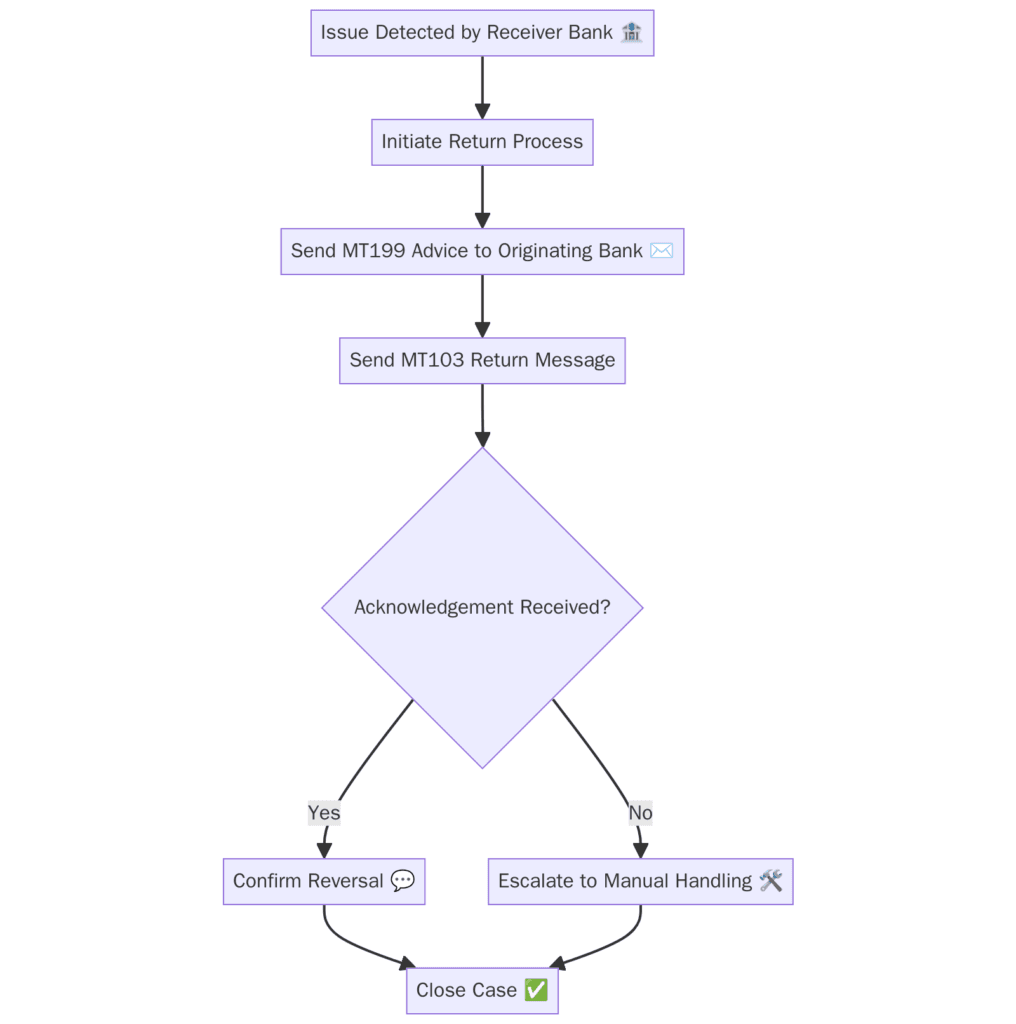In the world of international banking, the SWIFT MT103 message is a cornerstone for cross-border payments. But what happens when a payment fails or needs to be returned? That’s where MT103 Return messages come into play—and their modern ISO 20022 (MX) equivalents like pacs.004.
In this post, we’ll break down:
✅ What an MT103 Return is
✅ The ISO 20022 (MX) equivalent (pacs.004) for returns
✅ A real-life SWIFT MT103 Return message example (including :72: tag usage)
✅ A pacs.004 payment status report example
✅ The message flow between banks
Let’s dive in!
Table of Contents
What is an MT103 Return?
An MT103 Return occurs when a payment sent via MT103 cannot be completed and needs to be refunded to the sender. This can happen due to many reasons but here are few:
- Incorrect beneficiary details
- Closed bank account
- Regulatory restrictions
- Insufficient funds
Unlike an outright rejection (which happens before funds are credited), a return happens after the payment has been processed but cannot be settled.

MT103 Return vs. ISO 20022 (MX) Equivalent
With the global shift to ISO 20022, the traditional MT103 Return has an MX alternative:
| SWIFT MT (Legacy) | ISO 20022 (MX) Equivalent |
|---|---|
| MT103 (Payment) | pacs.008 (FIToFICstmrCdtTrf) |
| MT103 Return (via MT196/MT199) | pacs.004 (FIToFIPmtStsRpt) |
Key Differences:
- MT103 Returns often use MT196 (Request for Return) or MT199 (Free-Format Message) to initiate the refund. These messages will be explaining in articles ahead.
- In ISO 20022, pacs.004 is used to report the status of a payment, including returns.
Process Flowchart for MT103 Return

Real-Life MT103 Return Example
Here’s how an actual MT103 Return might look in SWIFT format, including the important :72: (Sender to Receiver Information) field:
{1:F01SENDERBANKXXXXXX0000000000}{2:I103RECEIVERBANKXXXXXXN}{4:
:20:REF123456789
:23B:CRED
:32A:240330USD10000,
:50K:/123456789
SENDER NAME
SENDER ADDRESS
:52A:SENDERBANKXXXX
:57A:INTERMBANKXXXX
:59:/987654321
WRONG BENEFICIARY NAME
BENEFICIARY ADDRESS
:70:PAYMENT FOR INVOICE 1234
:71A:SHA
:72:/RETN//BENEFICIARY ACCOUNT CLOSED
-}Key Fields Explained:
:72:– Used to provide return-related information. In this case:/RETNindicates this is a return message//BENEFICIARY ACCOUNT CLOSEDprovides the specific reason
If this payment fails, the receiving bank may send an MT196 to request a return:
{1:F01RECEIVERBANKXXXXXX0000000000}{2:I196SENDERBANKXXXXXXN}{4:
:20:REF123456789
:21:RETURN12345
:76:/123456789
//REASON
BENEFICIARY ACCOUNT CLOSED
:72:/RETN//PLEASE REFUND TO ORIGINATOR
-}ISO 20022 pacs.004 Example
When using ISO 20022, the pacs.004 message is sent to report a failed or returned payment. Here’s an example:
<Document xmlns="urn:iso:std:iso:20022:tech:xsd:pacs.004.001.09">
<FIToFIPmtStsRpt>
<GrpHdr>
<MsgId>STATUS12345</MsgId>
<CreDtTm>2024-03-30T10:00:00</CreDtTm>
</GrpHdr>
<TxInfAndSts>
<OrgnlInstrId>REF123456789</OrgnlInstrId>
<OrgnlEndToEndId>E2E123456789</OrgnlEndToEndId>
<TxSts>RJCT</TxSts>
<StsRsnInf>
<Rsn>
<Cd>AC04</Cd> <!-- Closed Account -->
</Rsn>
<AddtlInf>Beneficiary account is closed</AddtlInf>
</StsRsnInf>
<OrgnlTxRef>
<Amt>
<InstdAmt Ccy="USD">10000.00</InstdAmt>
</Amt>
<Dbtr>
<Nm>SENDER NAME</Nm>
</Dbtr>
<DbtrAcct>
<Id>
<Othr>
<Id>123456789</Id>
</Othr>
</Id>
</DbtrAcct>
</OrgnlTxRef>
</TxInfAndSts>
</FIToFIPmtStsRpt>
</Document>Key Fields in pacs.004:
TxSts→ Status of the transaction (RJCT= Rejected,ACTC= Accepted)StsRsnInf→ Reason for rejection (e.g.,AC04= Closed Account)OrgnlTxRef→ Original payment details
MT103 Return Flow Diagram
sequenceDiagram
participant Sender Bank
participant Receiver Bank
participant Beneficiary Bank
Sender Bank->>Receiver Bank: Sends MT103 (with :72:/RETN if needed)
Receiver Bank->>Beneficiary Bank: Forwards Payment
alt Payment Fails (MT)
Beneficiary Bank->>Receiver Bank: Sends MT196 (with :72: instructions)
Receiver Bank->>Sender Bank: Processes MT196 & Returns Funds
Sender Bank->>Original Sender: Credits Back Amount
else Payment Fails (MX)
Beneficiary Bank->>Receiver Bank: Sends pacs.004 (Status Report)
Receiver Bank->>Sender Bank: Processes pacs.004 & Reverses Payment
else Payment Successful
Beneficiary Bank->>Receiver Bank: Confirms Credit
endKey Takeaways
✔ MT103 Returns happen when a payment cannot be completed post-processing.
✔ The ISO 20022 equivalent is pacs.004 (instead of MT196/MT199).
✔ :72: field is crucial for return instructions in MT messages (/RETN flag).
✔ pacs.004 provides structured rejection reasons (e.g., AC04 for closed accounts).
✔ Returns are usually due to incorrect details, closed accounts, or compliance issues.
✔ The industry is shifting from MT to MX, making payment tracking more efficient.
Final Thoughts
Understanding MT103 Returns and their ISO 20022 equivalents (pacs.004) is crucial for banks, corporates, and fintechs handling cross-border payments. The :72: tag plays a vital role in communicating return information in the SWIFT MT format, while pacs.004 offers more structured data in the ISO 20022 world.
Have you encountered an MT103 Return or pacs.004 in your transactions? Share your experience in the comments!
🔗 Related Topics: